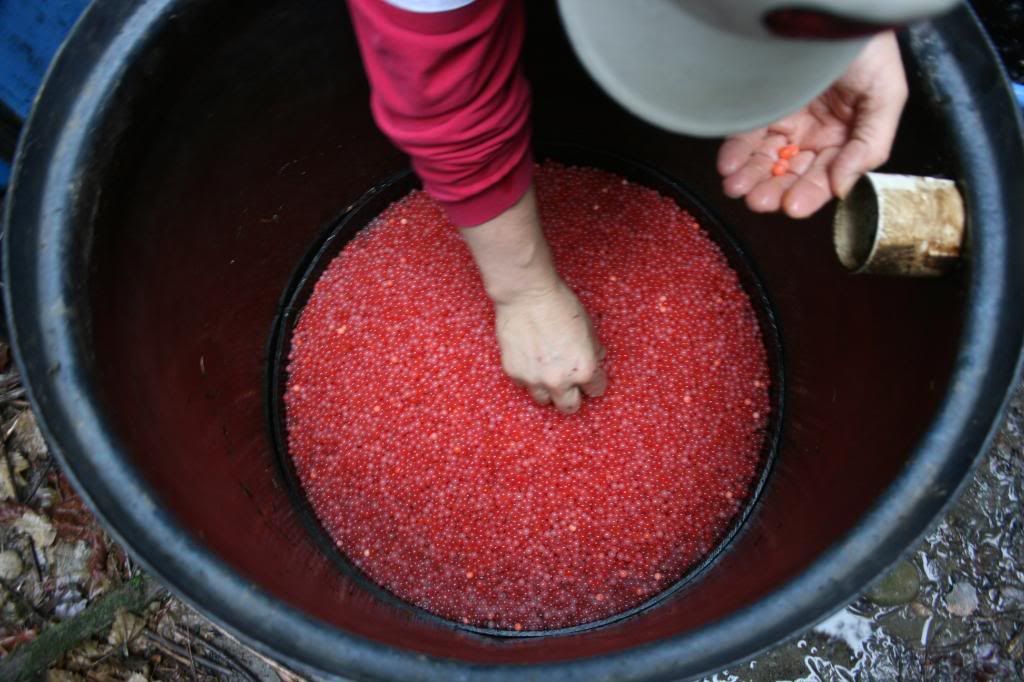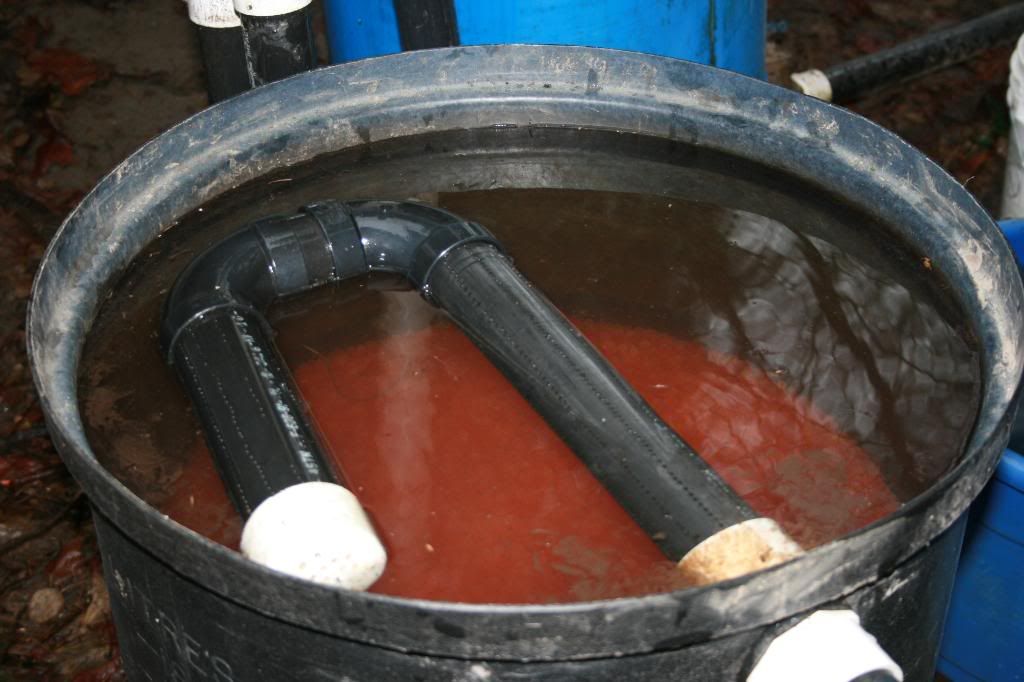
Once all the signatures were in place we headed out to the room were I have been picking up my eggs for the past 10 years.
There they were, just waiting for us.

The eggs were transferred into a scale so they can be weighed. Earlier the hatchery folks had weighed a sample and knew how many eggs were in a pound (1536, today), so they could figure out how many pounds of eggs to give us. Here the eggs go from the baskets to the scale.

The eggs were poured into the cheescloth bags I had brought with me.

The first year I went to get eggs, I was a rank amateur. I asked the hatchery tech how big a bucket I should bring to carry the eggs home.
To my surprise, he said, "None."
When I asked why, he asked me, "If I taped a bucket over your head and sealed it all up, do you think you could drive all the way home before you ran out of air?"
I said "No."
To which he replied, "Well neither can the fish. They will exhaust all of the oxygen in the water and then suffocate. If you bring breathable cloth bags and keep the eggs moist and out of any drafts, they'll transpire oxygen right out of the air through their egg casings."
As each bag was filled, I took it out to my pickup truck and placed it on the wet towel laid in the back. They were then covered with another towel for the ride home. Here they are resting happily for their ride to Lake Forest Park.

The water was flowing strongly through the incubator this morning, as it had been for the past several days. When I pass by, all I have to do is look at the angle of the water and the amount coming out to judge whether or not we are getting sufficient flow for the fish. The flow you see there is about 11 gallons/minute.

Before placing the eggs into the incubator there was an additional step; soaking the eggs in an iodine/creek water solution for 5 minutes. This soaking decreases the possibility of carrying any micro-organisms from the Issaquah Creek watershed into McAleer Creek's watershed. Here's the first bag of eggs in the solution.

While we were waiting for the eggs, we put the bag of plastic media and the first tray into the incubator.

Now comes one of the coolest parts of the process, pouring the eggs into the trays. The eggs are about the size of small peas and have a smooth, almost liquid consistency to them. They pour into the tray like a bright and spreading pink hill.

It's important to turn the bags inside out very carefully over the incubator, as some eggs invariably stick to the side of the bags. Any one of these little marvels could grow up to feed a seal, an orca, or even one of my blog readers (few as they are). Wouldn't want to miss any!

Now comes the tedious part. You have probably noticed in the pictures that some of the eggs are much lighter in color than the others. Those light, almost white, eggs are dead. Sadly, they don't all make it. An important part of the process, though is to remove the dead ones early on, so that they don't rot and kill any of their brethren (or sistren). You run your hands through the eggs to stir them up a bit and then take the dead ones out one at a time. Time consuming? Yes. Tedious? yes, again. But absolutely necessary to the health of the surviving eggs in the incubator.

Here's what healthy coho salmon eggs at the 'eyed' stage look like. Those two black dots will become the fish's eyes and that white line between the eyes will become the spinal cord of the fish (among other things). Amazing that something so small can eventually grow to be 8-15 lbs and 20-30 inches long.

Here's what a dead egg looks like; all white and opaque instead of translucent and vibrantly colored like the live ones. They even feel different; the live ones are resilient and kind of bouncy, the dead ones are hard and stiff.

As we picked the dead eggs out, we threw them into the creek. A bunch of them began to accumulate behind one of the rocks in the creek. The smell of the eggs was surely being wafted downstream. I was hoping that some scavenger like a crawdad, or maybe a trout, would come looking for this easy breakfast. If they did come, it was after we were already gone.

We repeated the process twice more; putting down a new empty tray, soaking the eggs in iodine, pouring them in and picking out the dead ones. By 10:30 in the morning, Gwynedd and I had put approximately 70,000 coho salmon eggs into their new home beside McAleer Creek.

Thanks to Gwynedd for taking the pictures. She took many more than this; these were the prettiest ones that told the story.
1 comment:
Once more you have delivered a masterful and informative post, good sir. I am in the throws of a shame spiral for not emulating your behavior.
Also, it was super fun getting the eggs and putting them in the incubator.
Post a Comment